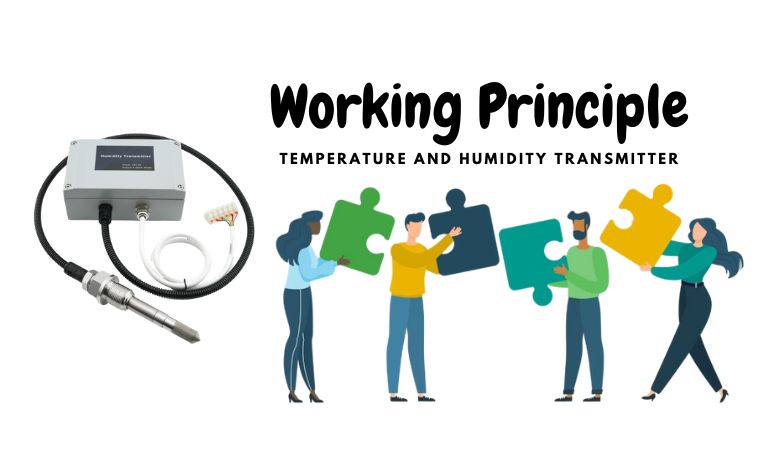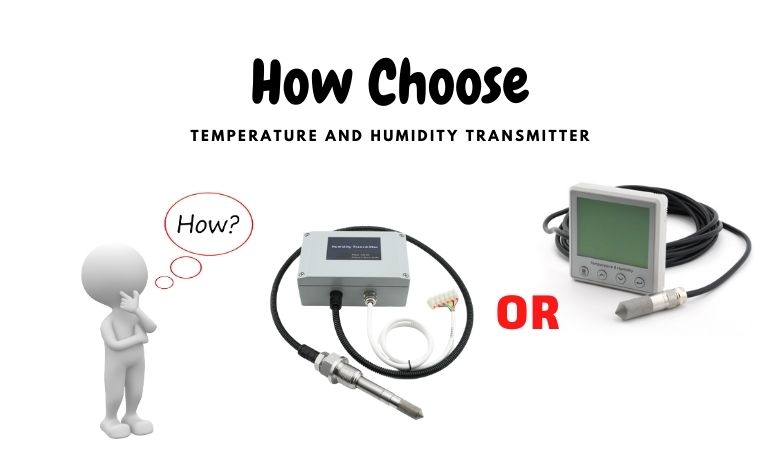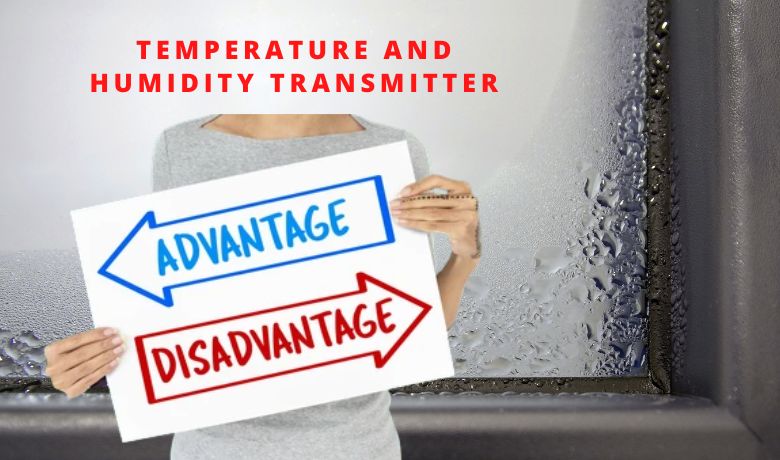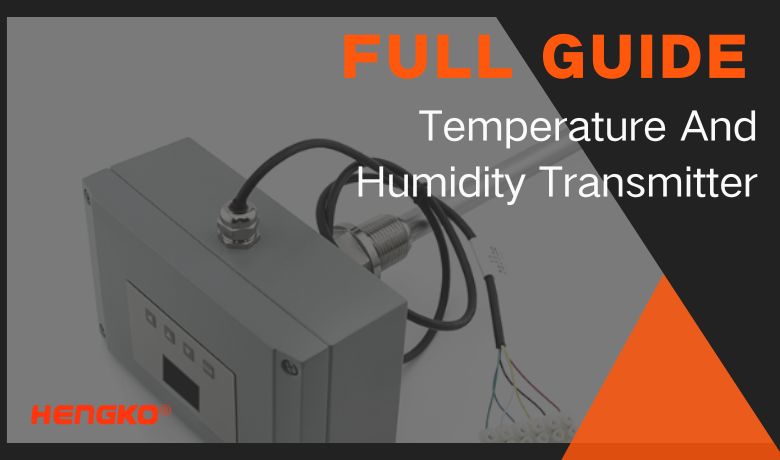What is a temperature and humidity transmitter?
A temperature and humidity transmitter is a device that measures and records the temperature and humidity levels in a specific area or environment. These devices are commonly used in various applications, including HVAC (heating, ventilation, and air conditioning) systems, food storage and processing facilities, and industrial and manufacturing environments.

What is the Temperature and Humidity Transmitter Working Principle?
A temperature and humidity transmitter is a device that measures temperature and humidity and transmits the data to a remote location, such as a control room or a computer. The working principle of a temperature and humidity transmitter is based on the physical properties of temperature and humidity.
Temperature is typically measured using a thermometer or a temperature sensor, such as a thermocouple or a resistance temperature detector (RTD). These devices work by measuring the temperature-dependent properties of a material, such as its resistance, voltage, or thermal expansion.
Humidity is typically measured using a hygrometer or a humidity sensor, such as a capacitive humidity sensor or a resistive humidity sensor. These devices work by measuring the humidity-dependent properties of a material, such as its capacitance, resistance, or dielectric constant.
The temperature and humidity sensor outputs are typically processed by a microprocessor or microcontroller, which converts the sensor readings into a digital format that can be transmitted over a communication network. The transmitter sends the data to a remote location, where it can be displayed, logged, or used to control other devices or processes.
Some temperature and humidity transmitters also have additional features, such as alarms, data logging, or the ability to adjust the temperature or humidity setpoints. These features can be controlled remotely through a computer or a handheld device.
Difference a Temperature and Humidity Transmitter and a Temperature and Humidity Sensor
One key difference between a temperature and humidity transmitter and a temperature and humidity sensor is that a transmitter is designed to transmit the measured data to a remote location or system. In contrast, a sensor is designed to measure and record the data. A transmitter is typically used when the data needs to be monitored and recorded remotely. In contrast, a sensor is used when the data only needs to be measured and recorded locally.
How to Choose a Temperature and Humidity Transmitter?
When choosing a temperature and humidity transmitter, it is important to consider the specific needs of your application. Some factors to consider are the type of environment in which the transmitter will be used, the range of temperatures and humidity levels that need to be measured, and the accuracy and precision required for your specific application. Other factors to consider are:
- The Device's durability.
- The Type of output it provides (analogue or digital).
- The Type of sensors it uses (thermistor, RTD, or capacitive).

1) When selecting a temperature and humidity transmitter, it is important to consider the specific needs of your application and choose a device that can accurately and reliably measure and transmit the data you need. Some important features include a wide range of temperature and humidity measurement capabilities, high accuracy and precision, and durable construction.
2.) Another factor to consider when selecting a temperature and humidity transmitter is the type of output it provides. Some transmitters offer analogue output, which provides a continuous signal that can be read and interpreted by a device or system. Digital output, on the other hand, provides discrete numerical data that can be easily transmitted and processed by a computer or other digital device.
3.) In addition to the output type, it is also important to consider the type of sensors used in the transmitter. The most common types of temperature sensors include thermistors, RTDs (resistance temperature detectors), and capacitive sensors. Each of these sensors has unique characteristics and capabilities, and the type of sensor used can impact the accuracy and precision of the measured data.
In summary, a temperature and humidity transmitter is a device that measures and records temperature and humidity levels in a specific area or environment; It is important to consider the specific needs of your application to choose a temperature and humidity transmitter, including the range of temperatures and humidity levels that need to be measured, the accuracy and precision required, and the type of output and sensors used. A temperature and humidity transmitter differs from a temperature and humidity sensor because it is designed to transmit the measured data to a remote location or system. In contrast, a sensor is designed to measure and record the data.
Advantages and Disadvantages of Temperature and Humidity Transmitters?
Advantages of Temperature and Humidity Transmitters:
1. Accurate and reliable measurement: Temperature and humidity transmitters are designed to provide accurate and reliable measurements of temperature and humidity levels.
2. Remote monitoring: Temperature and humidity transmitters can transmit the measured data to a remote location or system, allowing for real-time monitoring and control.
3. Wide range of applications: Temperature and humidity transmitters are used in many applications, including HVAC, food storage and processing, and industrial and manufacturing environments.
4. Easy to install: Temperature and humidity transmitters are typically easy to install and require minimal maintenance.
5. Durable construction: Many temperatures and humidity transmitters are designed with durable construction to withstand harsh environments and conditions.
6. Multiple output options: Temperature and humidity transmitters are available with both analogue and digital output options, allowing for data transmission and processing flexibility.

Disadvantages of Temperature and Humidity Transmitters:
1. Cost: Temperature and humidity transmitters can be more expensive than other temperature and humidity sensors.
2. Complexity: Some temperature and humidity transmitters can be complex and require specialized training.
3. Limited range: Temperature and humidity transmitters may have limited measurement ranges, depending on the specific model and application.
4. Calibration required: Temperature and humidity transmitters may require periodic calibration to ensure accurate measurements.
5. Power requirements: Some temperature and humidity transmitters may require a power source, which may not be available in all environments.
6. Dependence on external systems: Temperature and humidity transmitters rely on external systems for data transmission and processing, which may be subject to interference or connectivity issues.
What are the 12 Applications of Temperature and Humidity Transmitters?
1. HVAC (heating, ventilation, and air conditioning) systems: Temperature and humidity transmitters are used in HVAC systems to monitor and control the temperature and humidity levels in buildings and other structures.
2. Food storage and processing: Temperature and humidity transmitters are used in food storage and processing facilities to ensure the proper temperature and humidity conditions are maintained to prevent spoilage and food safety.
3. Industrial and manufacturing environments: Temperature and humidity transmitters are used in industrial and manufacturing environments to monitor and control the temperature and humidity levels for processes such as drying, curing, and baking.
4. Greenhouses and agriculture: Temperature and humidity transmitters are used in greenhouses and agricultural settings to monitor and control the temperature and humidity levels for optimal plant growth.
5. Museums and art galleries: Temperature and humidity transmitters are used in museums and art galleries to monitor and control the temperature and humidity levels to protect delicate and valuable artefacts and artwork.
6. Libraries and archives: Temperature and humidity transmitters are used in libraries and archives to monitor and control the temperature and humidity levels to preserve books, documents, and other historical materials.
7. Laboratories: Temperature and humidity transmitters are used in laboratories to monitor and control the temperature and humidity levels for scientific research and experiments.
8. Data centres: Temperature and humidity transmitters are used to monitor and control the temperature and humidity levels to protect sensitive computer equipment and data.
9. Hospitals and healthcare facilities: Temperature and humidity transmitters are used in hospitals and healthcare facilities to monitor and control the temperature and humidity levels to maintain a comfortable and healthy environment for patients and staff.
10. Retail environments: Temperature and humidity transmitters are used to monitor and control the temperature and humidity levels to maintain a comfortable shopping experience for customers.
11. Marine environments: Temperature and humidity transmitters are used to monitor and control the temperature and humidity levels on ships, boats, and other watercraft.
12. Aerospace: Temperature and humidity transmitters are used in aerospace applications to monitor and control aircraft and spacecraft temperature and humidity levels.
So What is your Projects? If also Need to Monitor Temperature and Humidity Transmitter
Maybe You Can Check Our Temperature and Humidity Transmitter Products Page to Check details.
Have any interested and questions, you are welcome to contact us by email ka@hengko.com, we will
send back to you asap within 24-Hours.
Send your message to us:
Post time: Dec-16-2022





